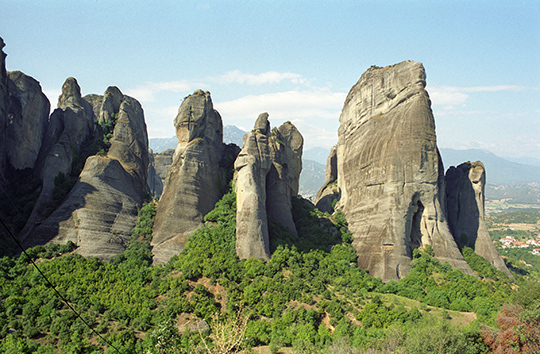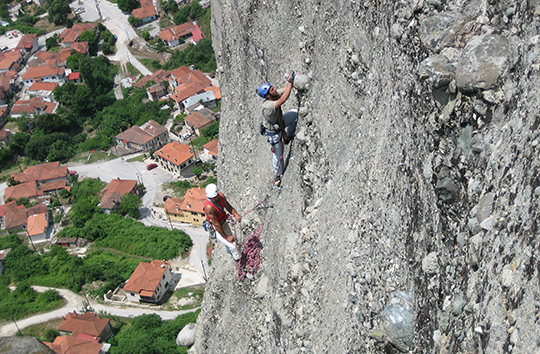
Meteora, Thessaly, Greece
The sweeping conglomerate pinnacles, fins and buttresses of Meteora, in central Greece, have long been a knobby playground for local and international climbers, and atop many of the formations lie the centuries-old monasteries of Eastern Orthodox monks. A recent plan submitted by the local archaeological office aims to restrict climbing and related recreation on most of the walls, arguing that such activities offend the peaceful monastic lifestyle. If passed, regulations would limit access to nearly three-quarters of the climbable cliffs.
Meteora’s Eastern Orthodox monks have inhabited the area’s formations since the 11th century, their monasteries perched between 650 and 1,970 feet high. “An early account by the nun Theotekni says…local climbers, shepherds, and hunters in the nearby town of Stagon knew the ascent routes and took monks to the summit,” Stewart Green writes in Rock Climbing Europe. Today, only four of the monasteries are active–Aghios Stephanos, Aghia Trias, Varlaam and Meteoron.
The cliffs and towers of Meteora are scattered and include both cultural and natural resources, recognized by the UNESCO World Heritage Convention, which strives to protect both cultural and natural heritage. The site was not acknowledged in its entirety until 1988, when Meteora received UNESCO World Heritage List status. In 1995, the Greek central government declared the area a sacred place. This classification allowed the monks a voice during discussions of land use but did not ban climbers’ access to most of Meteora’s walls.
According to local climbing guide and political scientist George Voutiropoulos, the walls of Meteora see visits from a few thousand climbers each year, a number that has fallen from an estimated 10,000 several years ago. Those who do visit the cliffs have historically had access to a mix of both unbolted and bolted climbs spanning more than 100 formations. “The older, classic lines…tend to be minimally bolted with large ringbolts, so protection is widely spaced,” Green writes. “Most new Meteora leaders, until they get used to the conglomerate and the necky, runout climbing, drop a grade or two for their leads on the classics.” In the 1970s, Dietrich Hasse, German first ascensionist and author of the area’s guidebook, established a verbal agreement with the government securing rights for climbers on all of the formations but six towers who hold or have recently held active monasteries, says local UIAGM guide Nikos Hadjis.

In a recent interview with Sundays Eleutherotypia, a representative from the Ministry of Culture argues that the proposed closures in Meteora are not motivated by opposition to climbing on the area’s walls. Instead, he says, the closures are an attempt to avoid disruption of the quiet monastic life. Eastern Orthodox monastics typically want to withdraw from the world, explains David Dunn, who received his doctorate in theological studies from Vanderbilt University. “They serve the world through prayer, by carving out a little piece of heaven on earth,” he told Alpinist. “[T]hey are more likely to make brief forays into the outside world than to walk the streets talking with the homeless or engag[ing] in social and political protest.”
Recently, a local bishop stressed that “religious tourism [has] risen to almost one million visitors per year in the area, where climbers are just a small minority,” Voutiropoulos says. “He recommended moving [climbers] to other undeveloped cliffs nearby.”

Following a planned Red Bull film shoot featuring a wingsuit flight over Meteora’s cliffs this summer, ekathimerini.com’s Christina Sanoudou reported that “the metropolitan bishop of Stagoi and Meteora, along with other high-ranking clerics in the area, filed official complaints with authorities, claiming that the use of the monastic site for commercial purposes is blasphemous.” It was not Red Bull’s first foray onto lands typically off-limits to outdoor recreationalists. Several years ago, the company paid the Navajo Nation to allow them access to film BASE jumping on the Totem Pole, one of several towers on Navajolands closed to climbing and related activities for spiritual reasons. Red Bull’s Meteora film shoot was canceled last week.
Multiple outlets have reported that the annual Petzl RocTrip, scheduled to stop in Meteora September 29-October 3, has failed to receive approval from the Greek Central Archeological Council (KAS) and has been postponed indefinitely as a result. At press time, however, Petzl’s Athlete Manager Erwan Le Lann maintains that the event will go forward as planned.

In an effort to protect the existing routes in Meteora, Voutiropoulos, along with the temporary Committee of Meteora Climbers, has been circulating a petition opposing the proposed closures. The archeological office has not yet released the proposed restriction to the public, and Voutiropoulos says that locals do not know when the ban might be passed. “The easiest way to confront complicated problems is to impose prohibitions, whereas the hard way is true protection, dialogue, mutual understanding and compromise,” the climbers’ petition argues. “We ask for a serious and civilized discussion on the issue and we stay reserved until it becomes true with terms of democracy, respect of all citizens and professional arguments.”
The Committee of Meteora Climbers’ press release argues that the ethics of the climbing community align with the protection of the World Heritage Site. “Meteora is for us the ‘sacred’ place of Greek climbing in the sense that the entire environment is highly respected and our actions there are governed by rather strict rules for absolute protection and preservation of the rocks,” the press release states. At press time, the petition has 1,721 signatures and is just 279 short of its goal.